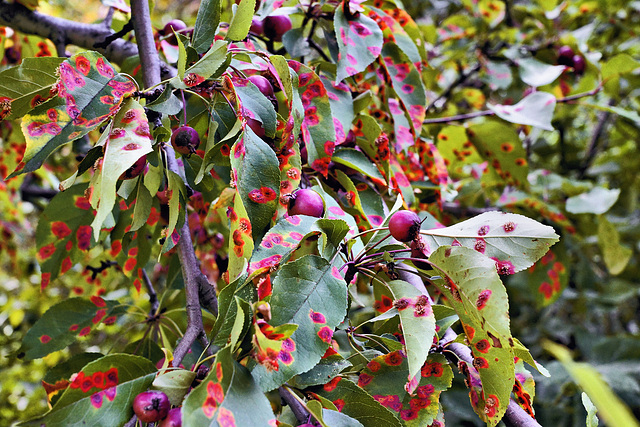Location
See also...
Keywords
Authorizations, license
-
Visible by: Everyone -
All rights reserved
-
393 visits
Crab Apples – de Maisonneuve Boulevard, Westmount, Québec


The leaves on this crabapple tree look like someone took a spray gun and peppered the leaves with orange and red paint. All those spots are signs of common fungus disease called cedar-apple rust. The fungus that causes cedar-apple rust has a pretty amazing life cycle (although it might be easier to marvel at if it weren’t making our apple and crabapple trees look so bad!). It needs to spend time growing on a juniper as well as an apple, as its scientific name Gymnosporangium juniperi-virginianae suggests, in order to complete its life cycle.
The first symptoms on apples are pale yellow spots on the upper surfaces of the leaves and on developing fruits in mid to late spring. The spots gradually get bigger and turn orange or red, and you may see black dots in the upper surface of the spots. In mid to late summer, if you turn the infected leaves over, you’ll see tiny tubes growing out of the spots. The ends of these tubes split open and curl back, releasing spores into the air.
Now these spores won’t infect more apples. They need to land on a red cedar, which in spite of its common name, is actually a juniper (Juniperus virginiana) . These spores form corky, one-quarter to two inch, reddish brown galls on the red cedar – sometimes called "cedar apples" – that take two seasons to mature. Then, in wet spring weather, gelatinous orange-colored "horns" emerge from the galls, looking for all the world like some alien creatures that have just landed from outer space. When the weather turns dry, the horns shrink and dry up, but re-emerge in the next rainy spell. They produce spores that are carried on air currents to apple leaves and the cycle of infection begins again.
The main damage is to the red cedars. But severely infected apples and crabapples can suffer enough leaf loss to weaken them or even kill them, and infected fruits are small and misshapen.
The first symptoms on apples are pale yellow spots on the upper surfaces of the leaves and on developing fruits in mid to late spring. The spots gradually get bigger and turn orange or red, and you may see black dots in the upper surface of the spots. In mid to late summer, if you turn the infected leaves over, you’ll see tiny tubes growing out of the spots. The ends of these tubes split open and curl back, releasing spores into the air.
Now these spores won’t infect more apples. They need to land on a red cedar, which in spite of its common name, is actually a juniper (Juniperus virginiana) . These spores form corky, one-quarter to two inch, reddish brown galls on the red cedar – sometimes called "cedar apples" – that take two seasons to mature. Then, in wet spring weather, gelatinous orange-colored "horns" emerge from the galls, looking for all the world like some alien creatures that have just landed from outer space. When the weather turns dry, the horns shrink and dry up, but re-emerge in the next rainy spell. They produce spores that are carried on air currents to apple leaves and the cycle of infection begins again.
The main damage is to the red cedars. But severely infected apples and crabapples can suffer enough leaf loss to weaken them or even kill them, and infected fruits are small and misshapen.
- Keyboard shortcuts:
Jump to top
RSS feed- Latest comments - Subscribe to the comment feeds of this photo
- ipernity © 2007-2024
- Help & Contact
|
Club news
|
About ipernity
|
History |
ipernity Club & Prices |
Guide of good conduct
Donate | Group guidelines | Privacy policy | Terms of use | Statutes | In memoria -
Facebook
Twitter

Sign-in to write a comment.